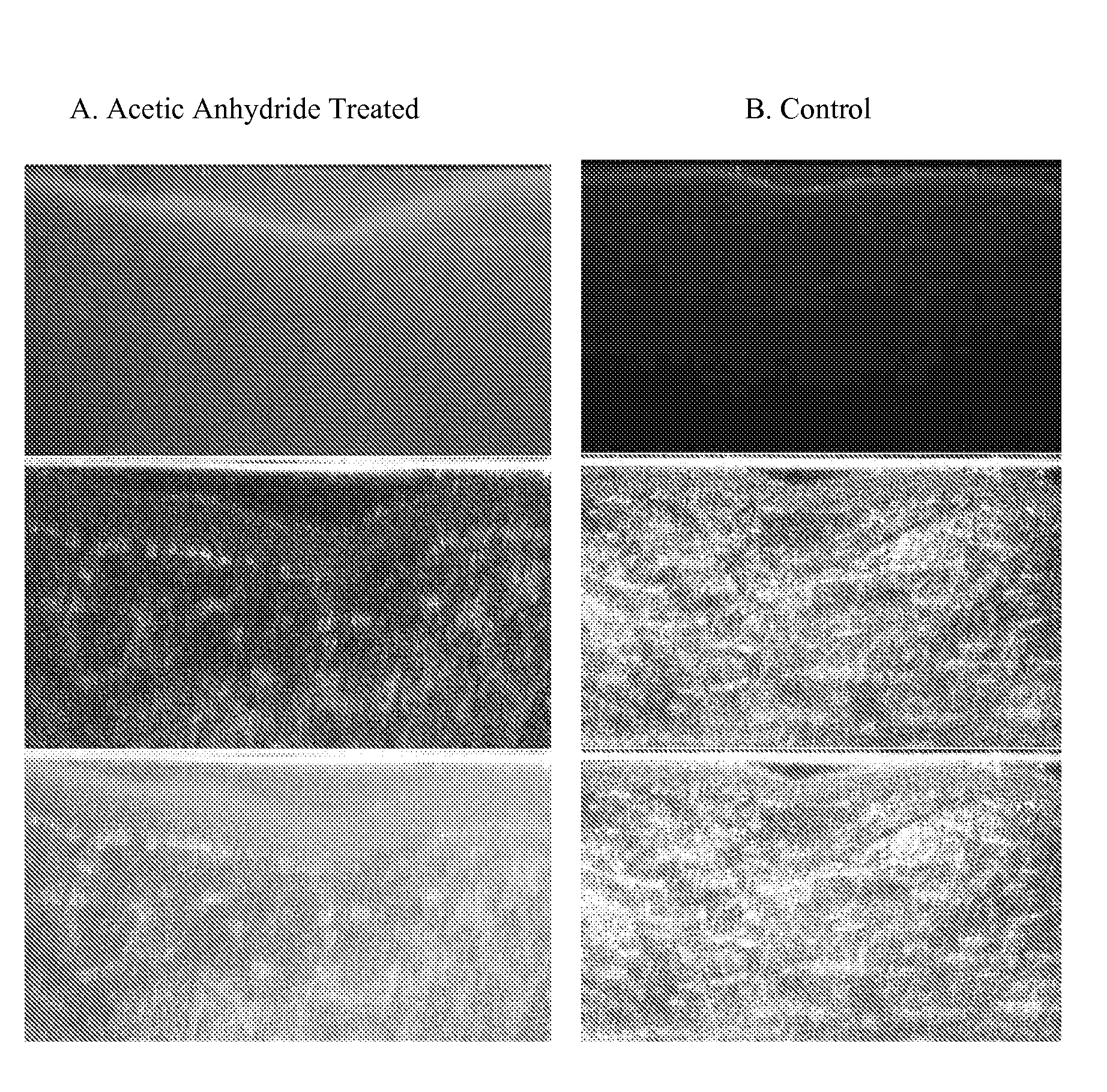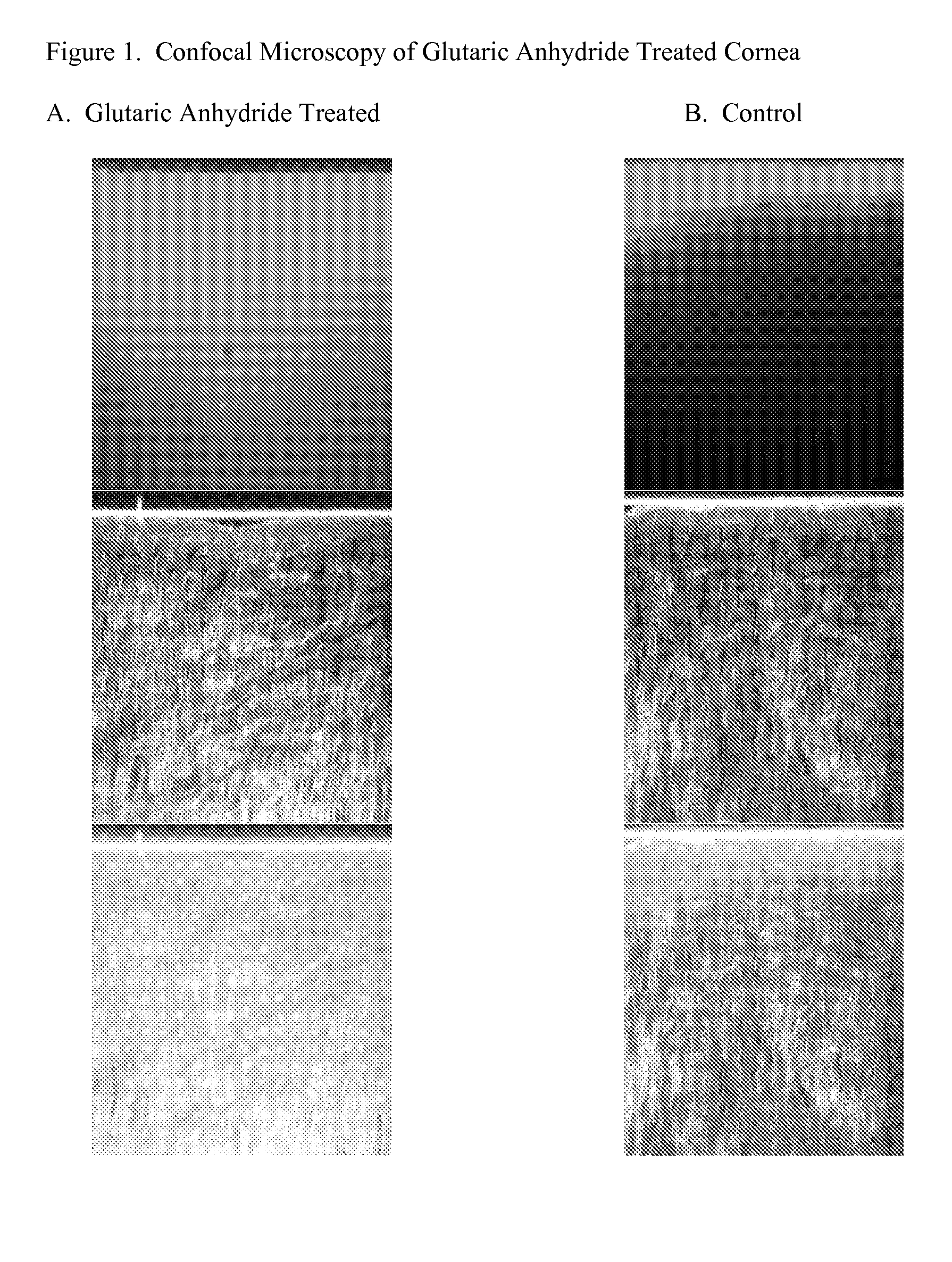Methods to increase permeability of corneal epithelium and destabilize stromal collagen fibril network
a stromal collagen and network technology, applied in the field of corneal epithelium permeability increase and destabilization of stromal collagen network, can solve the problems of corneoplasty induced astigmatism or double vision, wear of retainer lenses, and difficulty in accurately placing contact lenses with respect to the axis of vision to control the reshaping of corneal tissue, etc., to facilitate the stabilization of the reshaping corneal curvature and enhance the ocular delivery molecul
- Summary
- Abstract
- Description
- Claims
- Application Information
AI Technical Summary
Benefits of technology
Problems solved by technology
Method used
Image
Examples
example 1
Confocal Microscopy to Evaluate Decorin Penetration into Human Donor Corneal Tissue
[0082]Confocal Microscopy of glutaric anhydride treated cornea. Four donor corneas were obtained from Insight Biomed (Minneapolis, Minn.). All cornea tested negative for viral contamination. Corneas were rejected for transplantation due to storage expiration, low endothelial cell counts or other factors not related to epithelial cell integrity and stromal structure. All corneas were examined by slit-lamp microscopy for epithelial cell integrity. Corneas were stored in Optisol (Bausch & Lomb) for storage. Confocal microscopy was conducted at the Department of Surgical Research, Dartmouth-Hitchcock Medical Center, Lebanon, N.H. Two corneas were untreated controls and two were treated with glutaric anhydride followed by application of fluorescent-tagged human recombinant decorin. Human recombinant Decorin was prepared from CHO—S cells (Cardinal Health) and exhibited a concentration of 3.7 mg / mL in 10 mM ...
example 2
Transmission Electron Microscopy to Evaluate Decorin Binding to Collagen Stromal Fibers in Human Donor Corneal Tissue
[0087]The following study was conducted at the Department of Surgical Research, Dartmouth-Hitchcock Medical Center, Lebanon, N.H. Five adult female cats were included in the study. All animals procured from Liberty Laboratories and were identified by ear tattoo. Ocular toxicity was determined by slit-lamp examination and measurement of endothelial cell structure. Decorin penetration into the corneal stroma was determined utilizing transmission electron microscopy. Cornea treated with decorin were reacted with Quinolinic Blue Stain (Cupromeronic blue) in buffered formalin. This reagent stains small proteoglycan structures such as decorin.
[0088]Cats were placed in three treatment groups. One eye from each group was treated with decorin. Three eyes were controls. Treated eyes were exposed to 50 μg of decorin for 1 day, 3 days or 5 days. Decorin solution was administered ...
example 3
Effects of Acylation Treatments in Corneal Hysteresis in the Feline Model
[0094]Measurements of Corneal Hysteresis (CH) in the animals treated in Example 2. Corneal Hysteresis is a measure of the biomechanical strength of the cornea and is measured using the Reichert Ocular Response Analyzer. The Reichert Ocular Response Analyzer utilizes a dynamic bi-directional applanation process to measure the biomechanical properties of the cornea and the Intraocular Pressure of the eye. The basic output of the measurement process is a Goldmann-correlated pressure measurement (IOPG), and a new measure of corneal tissue properties called Corneal Hysteresis (CH). CH values are shown in Table 1.
TABLE 1CH values for Feline Study #1Corneal Hysteresis of Feline Cornea followingAcylation and Decorin TreatmentsAnimal IBT4Animal QKU8Animal QNO6TreatmentControlTreatedTreatedTreatedControlTreatedInitialND4.06.47.0ND6.3Post-ND7.08.07.5ND7.0ProparacainePost-GAND3.35.36.4ND6.4Post-AA #1ND3.27.05.7ND5.7Post-AA...
PUM
| Property | Measurement | Unit |
|---|---|---|
| Shape | aaaaa | aaaaa |
| Permeability | aaaaa | aaaaa |
| Hydrophilicity | aaaaa | aaaaa |
Abstract
Description
Claims
Application Information
 Login to View More
Login to View More - R&D
- Intellectual Property
- Life Sciences
- Materials
- Tech Scout
- Unparalleled Data Quality
- Higher Quality Content
- 60% Fewer Hallucinations
Browse by: Latest US Patents, China's latest patents, Technical Efficacy Thesaurus, Application Domain, Technology Topic, Popular Technical Reports.
© 2025 PatSnap. All rights reserved.Legal|Privacy policy|Modern Slavery Act Transparency Statement|Sitemap|About US| Contact US: help@patsnap.com



